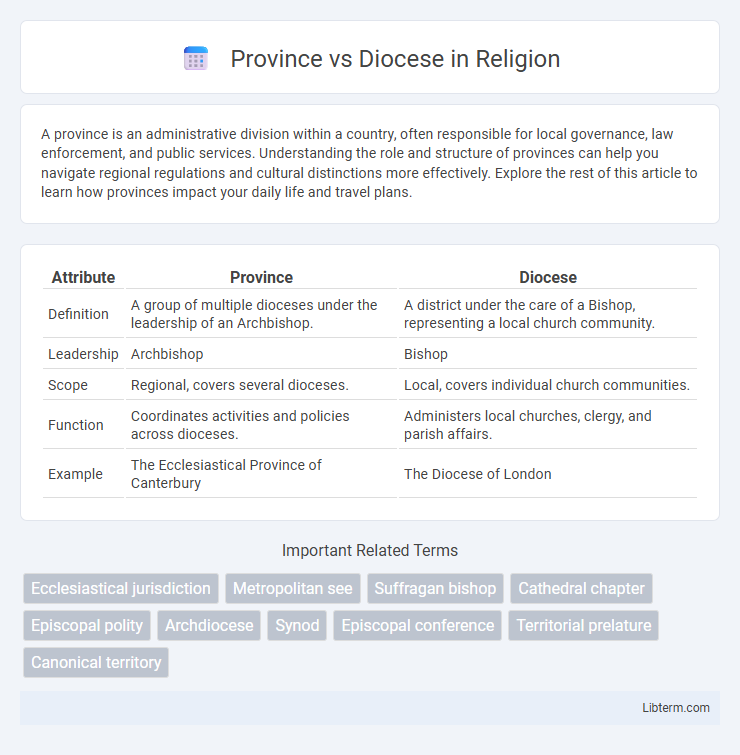A province is an administrative division within a country, often responsible for local governance, law enforcement, and public services. Understanding the role and structure of provinces can help you navigate regional regulations and cultural distinctions more effectively. Explore the rest of this article to learn how provinces impact your daily life and travel plans.
Table of Comparison
| Attribute | Province | Diocese |
|---|---|---|
| Definition | A group of multiple dioceses under the leadership of an Archbishop. | A district under the care of a Bishop, representing a local church community. |
| Leadership | Archbishop | Bishop |
| Scope | Regional, covers several dioceses. | Local, covers individual church communities. |
| Function | Coordinates activities and policies across dioceses. | Administers local churches, clergy, and parish affairs. |
| Example | The Ecclesiastical Province of Canterbury | The Diocese of London |
Definition of Province and Diocese
A province in ecclesiastical terms refers to a cluster of dioceses under the jurisdiction of an archbishop, serving as a regional church administrative unit. A diocese is a district or area overseen by a bishop, functioning as the basic organizational unit of the church, responsible for local congregations and parishes. The distinction lies in scale and hierarchy, with provinces encompassing multiple dioceses for broader governance.
Historical Origins
A province in ecclesiastical terms historically refers to a group of dioceses overseen by a metropolitan bishop, a system that emerged in the early Christian Church as a means to organize and manage regional church affairs effectively. The diocese originated from the Roman administrative division during the 4th century, adopted by the Church to delineate territorial jurisdictions under a bishop's authority. This hierarchical structure allowed for more centralized control and better coordination of religious activities across expanding Christian territories.
Geographical Boundaries
A province in ecclesiastical terms typically encompasses multiple dioceses, serving as a larger geographical division within a church's hierarchy, often led by an archbishop. A diocese represents a single regional jurisdiction under the authority of a bishop, with clearly defined territorial boundaries that manage local parishes and congregations. The distinction lies in scale and governance, as provinces coordinate broader regional activities while dioceses administer precise local church functions.
Administrative Structure
A province in ecclesiastical terms is a larger administrative unit composed of multiple dioceses, overseen by an archbishop or metropolitan who coordinates regional church governance and policies. Each diocese functions as a distinct administrative area led by a bishop, responsible for managing local parishes, clergy, and religious activities within its defined geographic boundaries. The hierarchical structure places the province as a superior entity ensuring doctrinal uniformity and strategic leadership across dioceses.
Leadership Roles
A province in ecclesiastical terms is a larger administrative region typically overseen by an archbishop who provides leadership and coordination among multiple dioceses. A diocese is a smaller territorial unit led by a bishop responsible for pastoral care, governance, and administration within that specific area. Leadership in a province involves strategic oversight and support for diocesan bishops, while a bishop directly manages clergy, sacraments, and local church activities.
Functions and Responsibilities
A province in ecclesiastical terms is a collection of dioceses under the leadership of a metropolitan archbishop, coordinating regional church governance, doctrinal consistency, and inter-diocesan activities. A diocese functions as the fundamental ecclesiastical jurisdiction led by a bishop, overseeing local parishes, clergy administration, sacramental services, and pastoral care within its defined geographical area. The province ensures unity and standardized practices across multiple dioceses, while each diocese executes direct spiritual leadership and community engagement on a localized level.
Relationship Between Province and Diocese
A province consists of multiple dioceses grouped under the leadership of an archbishop or metropolitan, establishing a hierarchical structure within the church administration. Each diocese operates as a distinct territorial jurisdiction governed by a bishop who oversees local parishes and clergy. The relationship between province and diocese ensures coordinated governance, doctrinal unity, and resource sharing across the broader ecclesiastical region.
Importance in Religious Organization
A province in a religious organization typically comprises multiple dioceses, serving as a larger administrative region that ensures doctrinal unity and coordinated governance. A diocese represents a specific local community under the pastoral care of a bishop, focusing on direct spiritual leadership and the management of parishes. The hierarchical structure where provinces oversee dioceses is crucial for maintaining consistent religious practices and supporting effective communication within the broader religious institution.
Examples Around the World
A province in ecclesiastical terms typically refers to a group of dioceses under the jurisdiction of a metropolitan archbishop, such as the Province of Canterbury in the Church of England overseeing several dioceses including London and York. Dioceses are individual districts headed by a bishop, exemplified by the Diocese of Rome in the Catholic Church, governed by the Pope as its bishop. Around the world, the Archdiocese of Sydney acts as a metropolitan province within the Catholic Church in Australia, coordinating multiple suffragan dioceses like Wollongong and Parramatta.
Modern-Day Relevance
A province in ecclesiastical terms refers to a group of dioceses under the jurisdiction of a metropolitan archbishop, serving as an administrative layer within larger church structures like the Roman Catholic or Anglican Churches. Dioceses operate as the fundamental territorial units governed by bishops, responsible for pastoral care, local governance, and community engagement. In modern-day relevance, provinces coordinate regional church policies and foster cooperation among dioceses, while dioceses maintain direct interaction with congregants and manage parish activities, highlighting their complementary roles in contemporary church organization.
Province Infographic

 libterm.com
libterm.com